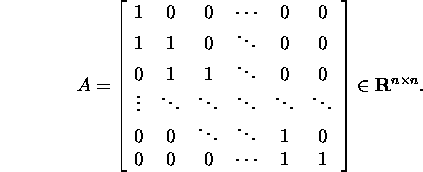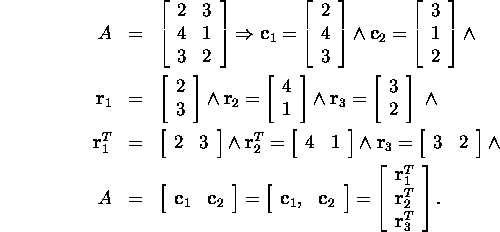The vector space of all ![]() matrices
with real elements will be denoted by
matrices
with real elements will be denoted by ![]() and
and

The element of the matrix A that stands in the i-th row and
k-th column will be denoted by aik or A(i,k)
or [A]ik. The main operations with matrices are
following:
Problem 2.1.1.* Let

Find the matrix AB.
Problem 2.1.2.* Let

Find the matrix An-1.
Problem 2.1.3.* Let
![]()
Prove that
![]()
Example 2.1.1.* Let us show that
multiplication of matrices is not commutative.
Let
![]()
We find the products:
![]()
![]()
As ![]() does not hold for the example, multiplication of matrices is not commutative
in general.
does not hold for the example, multiplication of matrices is not commutative
in general.
Proposition 2.1.1. If ![]() and
and ![]() then
then
![]()
Proof. If C=(AB)T,
then
![]()
If D=BTAT, we also have
![]()
![]()
Definition
2.1.1. A matrix ![]() is called symmetric if AT=A and skew-symmetric
if AT=-A.
is called symmetric if AT=A and skew-symmetric
if AT=-A.
Problem 2.1.4.* Is matrix A symmetric
matrix or skew-symmetric matrix if

Proposition 2.1.2. Each matrix ![]() can be expressed as a sum of a symmetric matrix
and a skew-symmetric matrix.
can be expressed as a sum of a symmetric matrix
and a skew-symmetric matrix.
Proof. Each matrix ![]() can be expressed as A=B+C, where B=(A+AT)/2
and C=(A-AT)/2. As
can be expressed as A=B+C, where B=(A+AT)/2
and C=(A-AT)/2. As
![]()
and
![]()
the proposition holds. ![]()
Problem 2.1.5.* Represent the matrix

as a sum of a symmetric and a skew-symmetric
matrix.
Definition
2.1.2. If A is a ![]() matrix
with complex elemtnts, i.e.,
matrix
with complex elemtnts, i.e., ![]() then the transposed scew-symmetric matrix AH will
be defined by the equality
then the transposed scew-symmetric matrix AH will
be defined by the equality
![]()
Definition 2.1.3. A
matrix ![]() is called an Hermitian matrix if
is called an Hermitian matrix if
![]()
Problem 2.1.6.* Is matrix A an
Hermitian matrix if

Problem 2.1.7.* Let ![]() Show that matrices AAH and AHA are
Hermitian matrices.
Show that matrices AAH and AHA are
Hermitian matrices.
The matrix ![]() can be expressed both by the column-vectors
can be expressed both by the column-vectors ![]() k
= 1 : n) of the matrix A and by the row-vectors
k
= 1 : n) of the matrix A and by the row-vectors ![]() ( i = 1 : m ) of the transpose of matrix A ("pasting'' the
matrices of the column-vectors or of the transposed row-vectors)
( i = 1 : m ) of the transpose of matrix A ("pasting'' the
matrices of the column-vectors or of the transposed row-vectors)

where ![]() and
and ![]() and
and

Example 2.1.2. Let us demonstrate these notions
on a matrix ![]() :
:

If ![]() then A(i,:) denotes the i-th row of the matrix A,
i.e.,
then A(i,:) denotes the i-th row of the matrix A,
i.e.,
![]()
and ![]() denotes the k-th column of the matrix A, i.e.,
denotes the k-th column of the matrix A, i.e.,

If ![]() then
then
![]()
and if ![]() then
then

If ![]() and
and ![]() and
and ![]() where
where
![]()
then the corresponding submatrix is
